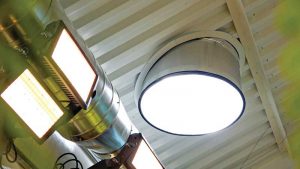
“We wanted to find a system that would work with our roof system easily and efficiently, and we came to 736.6-mm (29-in.), round TDDs,” says Poon. Ultimately, they chose a TDD featuring a unique bottom assembly component capable of delivering maximum daylight in high-ceiling applications.
Since most daylighting applications do not want damaging rays, all ultraviolet A and ultraviolet B (UVA and UVB) are removed at the roof dome level. For reptiles and amphibians that require UVA and UVB, it can be easily added back into the environment with electric lights.
The device also featured a prismatic diffuser and optional amplifier, which was key in helping focus sunlight down to specific areas in the enclosure. With the use of a daylight design software, the changes in light distribution can be seen. The amplifier significantly improves the delivery of daylight in high bay and high ceiling areas by reorienting the daylight to the visual task plane. It converts inefficient daylight angles into efficient angles.
In addition to its powerful channeling of daylight, the TDD selected was dual-glazed, providing significant insulation capable of maintaining the intense climate the dragons need. As far has high humidity is concerned, the entire system is sealed to prevent interior air/humidity from entering the optical system. The system is built in such a manner that it cannot “breath” at the roof level to equalize air expansion.
While the illumination output was of crucial importance in the redesign, another concern loomed: exhibit visibility. The design team needed to preserve the exhibit’s rugged natural appearance, keeping the zoo’s many visitors from seeing any infrastructural components that could shatter the immersive viewing experience.
The future renovation’s large observation area had to offer wide, unobstructed views into the enclosure, allowing guests to walk up to the glass to see the dragons. While most electrical and structural elements could be easily hidden or incorporated into the exhibit’s layout, the TDDs needed to operate unobstructed. However, their very functionality proved effective in mitigating this challenge.
TDDs are designed to allow flexibility, leading daylight to unconventional and hard-to-reach places. The reflective tubes are made with materials that can be easily adjusted on-site so the diffusers can be installed where needed. Using this feature, Poon could design the tubes to be hidden from view while still leading daylight to the desired locations.




